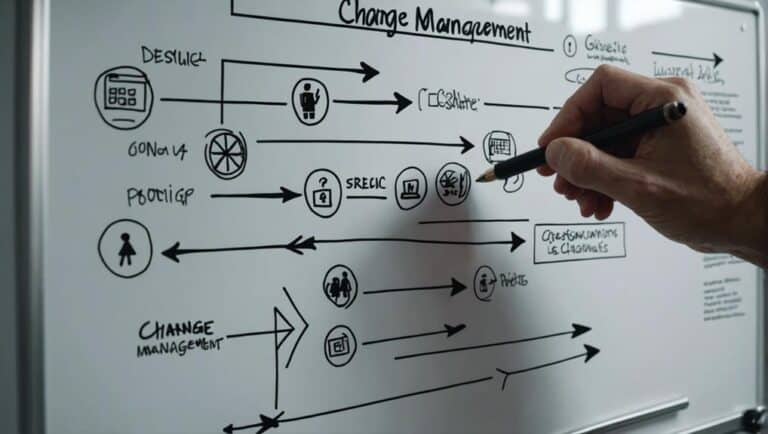As the modern workplace evolves, organizations must become adept at navigating the ever-changing landscape. Yet, there’s no denying change can be the most formidable challenge any workplace will ever face.
The biggest challenge of change in the workplace is often resistance from employees. Workers may be uncomfortable or uncertain about new processes, causing doubt and insecurity about their role. Leadership must provide clear communication, transparency, and guidance to combat these effects.
In this guide, we’ll dive into the most common challenges of change in the workplace and provide crucial strategies for overcoming them. By the end, you’ll have all the tools you need to lead your team through times of change and become even stronger on the other side. Let’s begin.
1. Resistance to Change
Have you ever found yourself feeling resistant to change at work? If so, you’re not alone. Change can be intimidating for anyone, especially when it involves shifting daily routines or taking on new responsibilities.
Feeling a little uneasy when faced with the unknown is perfectly natural. But as much as we might want to cling to the familiar, change is an inevitable part of life – especially in the workplace.
So how do we overcome employees’ resistance to change?
Here’s the secret: Communicate openly and transparently with them.
When we understand the reasons behind the change and how it will benefit the company and us, it can be easier to embrace the new direction. It’s also vital to listen to any concerns and address them proactively, too.
2. Communication During Times of Change
When things are shifting and changing around us, it’s crucial to stay informed and in the loop. That’s why effective communication matters so much.
By keeping your team informed and up-to-date on what’s happening and how it’ll impact them, you can help ease the transition and ensure everyone’s on the same page. You’ll be surprised by how far good communication will take you.
3. Managing Employee Emotions
From fear and anxiety to excitement and optimism, it’s essential to be mindful of the emotional toll that change can take on your team.
The secret to effectively managing employee emotions during change is to create a safe and supportive environment where employees feel comfortable expressing their feelings.
This might include providing opportunities for open and honest conversation, offering resources and support to help with the transition, and being proactive in addressing any concerns or challenges instead of sweeping them under the carpet.
It’s also wise to be empathetic and understanding of the different emotions your team may be experiencing. By showing your team that you care and you’re there to support them, you can help create a positive and resilient team culture that can weather the storms of change.
4. Ensuring a Smooth Transition
When managing change in the workplace, it’s helpful to ensure that the transition is as smooth as possible. After all, nobody wants to be caught off guard or feel like they’re being left in the dark. Planning and preparing for the change can help your team feel more confident and secure as you move forward.
Again, the best way to ensure a smooth transition is by clearly communicating the change details to your team. This means explaining the reasons for the change, how it might impact them, and what support will be provided to help with the transition.
5. Maintaining Productivity
When a company undergoes change, maintaining productivity can become a significant challenge. After all, when a new environment or different expectations unsettle employees, it’s difficult to stay focused and on-task.
So, to maintain productivity during times of change, managers and executives must be proactive in their approach.
It starts with communication and keeping employees informed of the changes going on within the organization. Of course, this doesn’t mean they need to know everything that’s going on all at once.
In fact, layering information in stages helps everyone prepare for how their roles may evolve. But providing clear guidelines and objectives for employee success is essential during transition periods.
By setting expectations early on and using ongoing communication to update employees as needed, skillful leaders can mitigate potential fallout from the disruption caused by change. Keeping the lines of communication open allows everyone involved to stay informed about changes and remain productive despite any uncertainty or disorder that may arise.
6. Effective Leadership During Times of Change
Leadership is an essential part of driving successful change in any organization. During times of transition, having clear and influential leaders at the helm is instrumental in keeping everyone informed and on track.
Leaders can start by creating a sense of trust among teams – demonstrating to their employees that they’re available to collaborate and communicate openly throughout the change process.
Leadership also means encouraging employees to think creatively when tackling new challenges or projects, which can help keep work engaging during periods of change.
Additionally, leaders must be willing to listen to employee feedback and address issues or concerns as they arise. This allows teams to stay connected, despite any disruption that may occur from a shift in company culture or operations.
7. Changes in Goals and Strategies
As organizations evolve, so must the strategies and goals that guide their progress. While this may be a daunting task for many businesses, it can also be an opportunity to re-evaluate current systems and processes with a fresh perspective.
A change in goals and strategies doesn’t have to be complicated – it can actually involve small yet meaningful shifts in how you approach projects or collaborations daily.
For instance, finding new ways to communicate within your team can help ensure a seamless transition. This could mean experimenting with different meeting formats like virtual workshops or brainstorming sessions.
Alternatively, connecting with colleagues through social media channels or other digital outlets could give everyone a more accessible platform for discussion.
No matter what changes you make, remember that the goal of any shift in plans or strategies should be to foster efficient operations and higher levels of collaboration within your organization.
With this mindset and a willingness to embrace change, companies can maximize their potential while navigating the ever-evolving business landscape.
8. Adjusting to Technology Changes
Change is unavoidable in the world of technology, but adjusting to new tools and processes doesn’t have to be complicated. Keeping up with the pace of tech advances can help ensure that teams are informed and operations stay efficient.
At the same time, organizations must take the time to understand how these changes will impact their teams on a practical level. A helpful strategy is to provide resources and support to help your team adapt to the new technology. This could include training, guidance, and additional support when it’s needed.
When you invest in your team’s success during times of change, you can help them feel more confident and capable of tackling the new challenges ahead.
And with careful planning and support, you can ensure your team can smoothly transition to new technology and drive success in the long run. So the next time you face a technology change at work, remember it’s all about finding ways to adapt and grow!
9. Workload and Responsibilities Changes
Change is an ever-present part of the workplace and can often impact workloads and responsibilities. Adjusting to these changes can be challenging, but there are ways to ensure everyone remains productive and motivated.
First, start by defining roles and tasks in an organized manner – this will help ensure everyone understands the project expectations before beginning new assignments or taking on additional work.
When setting up new tasks or processes, allow people to participate in decision-making as much as possible. This will create a feeling of ownership over their work and provide a sense of engagement that could positively impact morale.
Furthermore, empowering employees with autonomy over their schedules and goals can help them successfully tackle any changes that come their way. When managed correctly, changes in workloads and responsibilities don’t have to feel overwhelming – they can even be seen as opportunities for growth.
10. Changes to Policies and Procedures
Changes to policies and procedures can be a major source of stress and uncertainty in the workplace. Whether it’s a shift in how things are done or a change to the rules and regulations that govern your team, it’s essential to be prepared for the challenges of adapting to new policies and procedures.
Communicating the details of the change to your team is key to successfully navigating policies and procedures changes. Explain the reasons for the change, how it will impact them, and what support will be provided.
As well as listening to concerns and questions, proactively responding to them is crucial. The more transparency and clarity you provide, the more comfortable and prepared your team will feel.
11. Changes to Employee Benefits
A common challenge of change in the workplace is the alteration of employee benefits. This can be a sensitive and emotional topic for employees, as benefits such as healthcare and retirement plans can significantly impact their financial well-being.
Employees may feel uncertain or anxious about how the changes will affect them and their families. They can also feel betrayed or mistrustful towards their employer if the changes aren’t in their best interests.
As such, it’s wise for employers to approach changes to employee benefits with empathy and transparency and communicate the reasoning behind them. By approaching changes to employee benefits with care and openness, employers can minimize backlash and ensure a smooth transition for all parties involved.
12. Changes in Company Ownership or Management
Company ownership or management changes can affect employees’ roles and responsibilities, whether due to a merger, acquisition, or internal restructuring. That said, organizations should ensure their staff is well-prepared to handle any new expectations placed on them.
An effective transition strategy involves providing a clear, concise explanation of the transition process. Additionally, employers should regularly communicate with their personnel to answer any questions related to their job duties or personal needs.
13. Unclear Expectations or Goals
Unclear expectations or goals can be one of the most difficult challenges when implementing change in a workplace. Without clear guidance or direction, employees may feel confused and unmotivated, leading to frustration, resentment, and a decline in morale.
To minimize this issue, leadership must provide information on what needs to be done and how it should be done transparently.
Regularly scheduled meetings and open dialogue between management and staff are crucial for ensuring everyone is on the same page about the company’s objectives.
Additionally, leadership should strive to keep their messaging consistent and up-to-date at all times so that no one feels left out or unsure of the progress being made. By adopting this approach, leaders can help ensure their team members remain focused on achieving their goals, despite any potential disruptive change.
14. Inadequate Resources or Support
Not having the right resources or support can be a significant obstacle when implementing change in the workplace. Employees become overwhelmed or discouraged if they’re not given adequate tools and resources to succeed.
To meet this challenge, employers should ensure their employees have access to the latest resources and training. As part of the change process, employers should provide their staff with constant support and feedback to keep them motivated and engaged.
In most cases, employers can provide their teams with the necessary resources to succeed regardless of any incoming changes.
15. Maintaining Positive Workplace Morale
No matter what kind of change is being implemented, it’s essential to maintain positive workplace morale throughout the process.
By creating an atmosphere of open communication, providing clear expectations, and offering resources and support, employers can easily ensure their team is well-equipped to handle any disruptive changes.
But without a clear plan in place? Well, implementing change can become a real challenge.
One of the best ways to successfully implement change is to get everyone involved.
Open dialogue and regular check-ins with staff can create a sense of ownership and accountability, allowing everyone on the team to be part of the change process. In terms of morale, this will go a long way in helping employees stay engaged and motivated.
How Can Recognizing Toxic Work Environments Help Address Common Challenges of Change in the Workplace?
Recognizing toxic work environments is vital for addressing common challenges of change in the workplace. Without a clear understanding of the negative dynamics that may be fueling resistance or lack of adaptability, it becomes difficult to implement successful changes. By fostering toxic work environments recognition, organizations can identify underlying issues, promote healthier workplace cultures, and facilitate smoother transitions during periods of change.
Sources
- What Fix: 7 Barriers to Organizational Change (And How to Overcome Them)
- Chron: Barriers & Challenges to Change Implementation
- Pro Sci: Avoid These 5 Change Management Obstacles
- Forbes: Four Strategies For Overcoming The Challenge Of Change
- Harvard Business Review: The Hard Side of Change Management
- We Are Kadabra: 6 Barriers to Organizational Change, and How to Overcome Them
- Mind Tools: The Four Principles of Change Management





